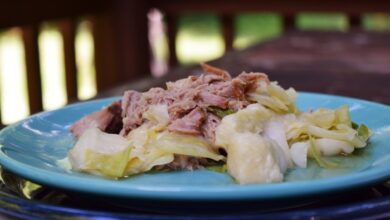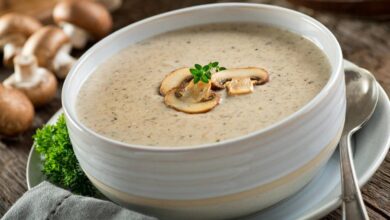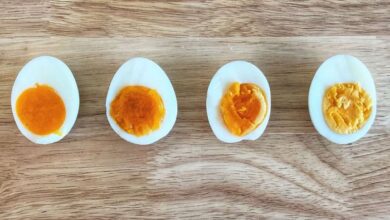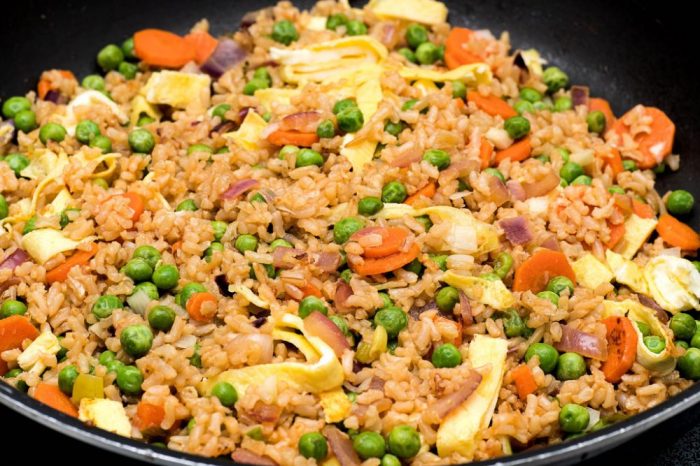
Easy Japanese Fried Rice: A Delicious and Versatile Dish
Easy Japanese fried rice is more than just a meal; it’s a culinary adventure that brings together flavors and textures in a harmonious symphony. This beloved dish is a staple in Japan and around the world, offering a simple yet satisfying experience.
Its origins can be traced back to centuries of culinary innovation, where humble ingredients were transformed into a masterpiece of taste and comfort.
The magic of Japanese fried rice lies in its versatility. Whether you’re craving a quick and easy weeknight dinner or a flavorful addition to your next gathering, this dish has you covered. With its customizable nature, you can tailor it to your preferences, adding your favorite vegetables, proteins, and spices.
But the true essence of Japanese fried rice lies in its perfect balance of savory, sweet, and umami flavors, achieved through a combination of soy sauce, mirin, and other essential ingredients.
The Appeal of Easy Japanese Fried Rice
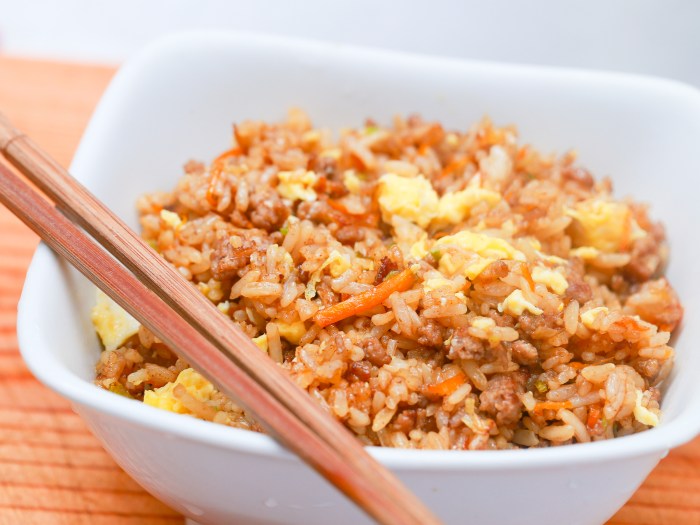
Japanese fried rice, oryakimeshi*, is a beloved dish worldwide, enjoyed for its versatility, flavor, and simplicity. Its popularity stems from its ability to be adapted to various tastes and dietary needs, making it a staple in many kitchens.
Cultural Significance of Japanese Fried Rice
Japanese fried rice holds a significant place in Japanese cuisine. It is a versatile dish that can be found in various settings, from casual street food stalls to upscale restaurants. The origins of Japanese fried rice can be traced back to the 19th century, when it was introduced by Chinese immigrants.
Over time, Japanese chefs adapted the dish to their own tastes and preferences, incorporating ingredients and flavors that are uniquely Japanese.
Key Ingredients and Flavors
The key ingredients and flavors that make Japanese fried rice unique include:* Rice:Japanese rice, known for its stickiness and ability to absorb flavors, is the foundation of this dish.
Soy Sauce
Soy sauce adds a savory and umami flavor to the rice.
Mirin
Mirin, a sweet rice wine, adds a touch of sweetness and depth to the dish.
Ginger and Garlic
Ginger and garlic are essential for their aromatic qualities, adding a distinct flavor to the fried rice.
Eggs
Eggs are often scrambled and added to the fried rice, adding richness and protein.
Vegetables
A variety of vegetables, such as onions, carrots, peas, and cabbage, are commonly used to add color, texture, and nutrients to the dish.
Meat or Seafood
Easy Japanese fried rice is a go-to for me when I’m short on time but want something flavorful and satisfying. I love the simplicity of the dish, with just a few key ingredients like rice, eggs, and vegetables. For a little extra indulgence, I often pair it with a side of creamy corn pudding, like this delicious recipe from Chef John’s Creamy Corn Pudding.
The sweetness of the corn complements the savory fried rice perfectly, making for a well-balanced meal.
Japanese fried rice can be customized with various meats and seafood, such as chicken, pork, shrimp, or beef.
Essential Ingredients and Their Roles
Japanese fried rice, often referred to as “yakimeshi,” is a versatile and flavorful dish that can be customized to your liking. While there are many variations, the core ingredients remain consistent, contributing to the dish’s unique character.
Easy Japanese fried rice is a weeknight staple in my kitchen. It’s so versatile, I can throw in whatever veggies I have on hand and it always comes out delicious. But sometimes, I crave something a little more decadent, like a eclair cake with chocolate ganache.
That rich, creamy filling and perfectly crisp pastry shell are just irresistible. But when I’m looking for a quick and satisfying meal, I always come back to my trusty Japanese fried rice recipe.
The Essential Ingredients, Easy japanese fried rice
The basic ingredients in Japanese fried rice are essential for achieving its characteristic flavor and texture. They form the foundation upon which you can build your own unique variations.
Easy Japanese fried rice is a staple in my kitchen – it’s quick, versatile, and always satisfying. But sometimes, I crave something a little more indulgent. That’s when I turn to gluten-free fried cheese curds – they’re the perfect crispy, cheesy side dish to complement the rice’s savory flavors.
Whether I’m enjoying a simple egg and vegetable fried rice or a more complex kimchi fried rice, these cheesy bites always hit the spot.
- Cooked Rice:The base of the dish, cooked rice provides the bulk and texture. Japanese short-grain rice, known for its stickiness, is preferred, as it holds its shape well when fried.
- Eggs:Eggs add richness and protein to the dish. They are often scrambled and mixed with the rice, contributing a delicate flavor and a subtle creaminess.
- Vegetables:Vegetables add freshness, crunch, and nutritional value. Common choices include onions, carrots, peas, and cabbage, but feel free to experiment with your favorites.
- Soy Sauce:A key ingredient that provides savory umami flavor. It also adds a slight saltiness and a touch of color to the rice.
- Mirin:A sweet rice wine that adds a subtle sweetness and depth of flavor to the dish.
- Sesame Oil:Adds a nutty aroma and flavor to the fried rice. It also contributes to the dish’s characteristic golden color.
- Salt and Pepper:These seasonings are used to balance the flavors and adjust the dish to your taste.
Ingredient Roles and Alternatives
The following table summarizes the roles of the essential ingredients and offers alternative options:
| Ingredient | Role | Alternative Options | Notes |
|---|---|---|---|
| Cooked Rice | Base of the dish, provides bulk and texture | Long-grain rice, brown rice, quinoa | Choose rice based on personal preference and desired texture. |
| Eggs | Adds richness, protein, and a delicate flavor | Omitted, tofu | Eggs can be omitted for a vegan version, and tofu can be used as a substitute. |
| Vegetables | Adds freshness, crunch, and nutritional value | Green beans, mushrooms, spinach, bell peppers | Use seasonal vegetables or those you prefer. |
| Soy Sauce | Provides savory umami flavor, saltiness, and color | Tamari, liquid aminos | Tamari is a gluten-free alternative to soy sauce. |
| Mirin | Adds subtle sweetness and depth of flavor | Sugar, honey | Mirin is a traditional ingredient, but you can use alternatives for a less sweet taste. |
| Sesame Oil | Adds nutty aroma and flavor, contributes to golden color | Vegetable oil, olive oil | Sesame oil is preferred for its unique flavor, but other oils can be used. |
| Salt and Pepper | Balances flavors and adjusts taste | Salt substitute, other spices | Adjust seasoning based on your preference and the other ingredients used. |
Simple Techniques for Perfect Rice
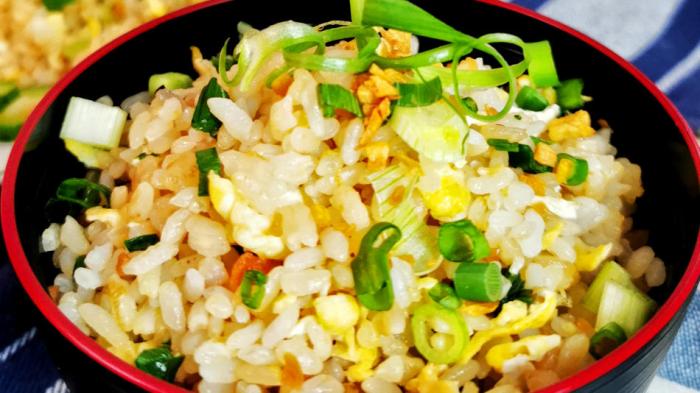
The foundation of any great Japanese fried rice is perfectly cooked rice. While many people use leftover rice, the secret to achieving that ideal texture lies in mastering the art of cooking rice specifically for fried rice. This involves a few simple techniques and considerations that will elevate your dish to new heights.
Cooking Rice for Fried Rice
Cooking rice for fried rice differs slightly from regular rice preparation. The goal is to achieve rice that is slightly firm, not mushy, and has a distinct grain separation. This allows the rice to absorb the flavors of the stir-fry ingredients and maintain a pleasant texture.
- Rinse the Rice:Before cooking, rinse the rice thoroughly under cold running water until the water runs clear. This removes excess starch, which can make the rice sticky.
- Use the Right Ratio:The ideal ratio for cooking rice for fried rice is 1:1.25, meaning 1 cup of rice to 1.25 cups of water. This ensures the rice cooks evenly and doesn’t become too dry or too wet.
- Bring to a Boil:Place the rinsed rice and water in a saucepan with a tight-fitting lid. Bring the mixture to a boil over high heat.
- Reduce Heat and Simmer:Once the water boils, reduce the heat to low and cover the pot. Simmer for 15-20 minutes without lifting the lid. This allows the rice to absorb the water and cook evenly.
- Rest and Fluff:After simmering, remove the pot from the heat and let the rice rest for 10-15 minutes with the lid on. This allows the rice to steam and finish cooking. Finally, fluff the rice with a fork to separate the grains.
Rice Variety and Texture
The type of rice used can significantly impact the texture of your fried rice.
- Short-Grain Rice:This type of rice is ideal for fried rice because it has a sticky texture that holds together well. It is commonly used in Japan and provides a classic fried rice experience.
- Medium-Grain Rice:While not as sticky as short-grain rice, medium-grain rice still provides a good texture for fried rice. It offers a slightly firmer bite and is a good alternative if short-grain rice is unavailable.
- Long-Grain Rice:This type of rice is less suitable for fried rice because it tends to be fluffy and doesn’t hold together as well. However, it can still be used if you prefer a less sticky texture.
Tips for Perfect Rice
- Avoid Overcooking:Overcooked rice becomes mushy and loses its distinct grain separation, which is undesirable for fried rice. Follow the cooking times closely to avoid overcooking.
- Use Fresh Rice:Fresh rice cooks more evenly and produces a better texture compared to older rice.
- Don’t Stir During Cooking:Resist the urge to stir the rice while it’s cooking. This can disrupt the even cooking process and lead to unevenly cooked rice.
- Let the Rice Cool:After cooking, let the rice cool completely before using it for fried rice. This helps the rice firm up and absorb the flavors of the stir-fry ingredients.
Flavor Profiles and Variations
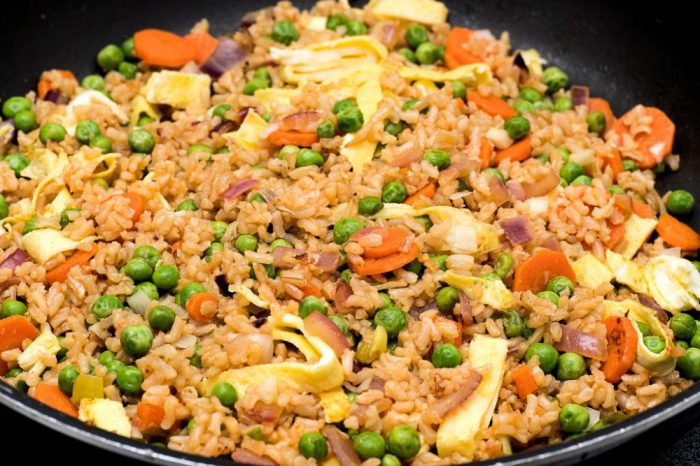
Japanese fried rice, while simple in its core ingredients, offers a world of flavor possibilities. By adjusting the seasonings, additional vegetables, and protein sources, you can create a wide array of flavor profiles to suit your taste.
Flavor Profiles and Their Key Ingredients
The most common flavor profiles in Japanese fried rice are:
- Soy Sauce-Based:This is the most classic and widely recognized flavor profile. It relies on the umami richness of soy sauce, often paired with a touch of sugar for balance.
- Oyster Sauce-Based:Oyster sauce adds a savory depth and slight sweetness, creating a more robust flavor than the soy sauce-based version.
- Spicy:Japanese fried rice can also be spiced up with chili peppers, chili oil, or a sprinkle of red pepper flakes.
- Citrusy:A squeeze of lemon or lime juice adds a bright and refreshing touch, often paired with ginger for a zesty kick.
| Flavor Profile | Key Ingredients | Variations | Example |
|---|---|---|---|
| Soy Sauce-Based | Soy sauce, sugar, sesame oil, green onions | Adding ginger, garlic, or a dash of mirin for added depth | Classic Japanese fried rice with pork, shrimp, and vegetables |
| Oyster Sauce-Based | Oyster sauce, garlic, ginger, Chinese sausage | Adding shiitake mushrooms, bamboo shoots, or a sprinkle of white pepper | Fried rice with a savory and umami-rich flavor, often featuring shrimp or chicken |
| Spicy | Chili peppers, chili oil, red pepper flakes | Adding chopped jalapeños, sriracha, or a dash of gochujang for extra heat | Fried rice with a fiery kick, perfect for those who enjoy spicy food |
| Citrusy | Lemon or lime juice, ginger, garlic | Adding a touch of soy sauce or mirin for balance | Fried rice with a bright and refreshing flavor, ideal for a lighter meal |
Customizing Flavor Profiles
The beauty of Japanese fried rice lies in its versatility. You can easily customize the flavor profile to suit your personal preferences. Here are some tips:
- Start with a base recipeand then experiment with different ingredients and seasonings. For example, if you like a soy sauce-based fried rice, try adding a pinch of ginger or garlic for a more complex flavor.
- Consider the protein source. Chicken, pork, shrimp, tofu, or even vegetables can be used as the main protein source. The flavor of the protein will influence the overall taste of the fried rice.
- Experiment with different vegetables. Adding chopped carrots, peas, spinach, or mushrooms will not only add color and texture but also enhance the flavor profile.
- Don’t be afraid to use fresh herbs. A sprinkle of chopped cilantro, parsley, or chives can add a fresh and vibrant touch to the dish.
Essential Cooking Techniques
Stir-frying is the heart of Japanese fried rice, and mastering this technique will elevate your dish from ordinary to extraordinary. The key lies in understanding the interplay of heat, timing, and ingredients.
Heat Control and Timing
The right heat is crucial for achieving that perfect crispy rice and tender vegetables. High heat is essential for quick cooking and achieving the signature crispy texture.
- Begin by heating your wok or pan over high heat. A hot wok will ensure that the rice browns quickly and evenly, while the vegetables cook rapidly and retain their vibrant colors and textures.
- Add a small amount of oil to the hot wok. This will prevent the rice from sticking and allow it to cook evenly. Use a neutral oil with a high smoke point, such as vegetable oil or peanut oil.
- Once the oil is hot, add the rice to the wok and stir-fry for a few minutes. This will ensure that the rice is heated through and becomes slightly crispy.
- Add the vegetables and protein next. Stir-fry them quickly until they are just cooked through. Overcooking will result in mushy vegetables.
- Finally, add the seasonings and sauce. Stir-fry for a few more seconds to combine all the flavors.

